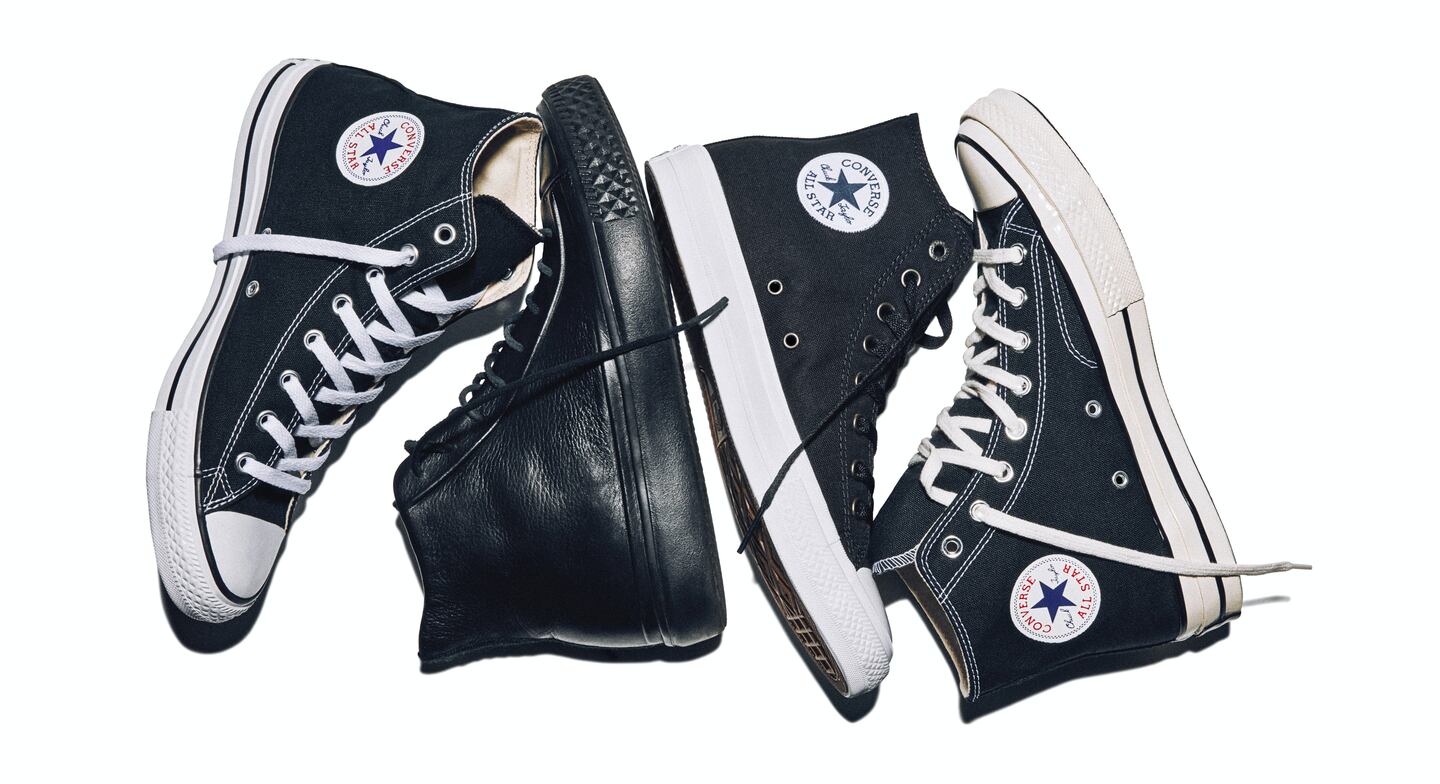
The Business of Fashion
Agenda-setting intelligence, analysis and advice for the global fashion community.

Agenda-setting intelligence, analysis and advice for the global fashion community.

BOSTON, United States — Inside Converse headquarters, housed in a former Schrafft candy factory overlooking the Zakim Bridge, museum-worthy displays of vintage shoes dot each open floor. A dedicated exhibit illustrates the brand's journey from sportswear upstart — starting with the first 1917 All Star, before coach-turned-salesman Chuck Taylor lent his name to the now-ubiquitous shoe — to counter-culture icon, worn by the likes of the Sex Pistols.
The past is very present at Converse, but the brand’s new leadership team is hoping it will not limit its future. Last summer, parent company Nike installed three of its executives at Converse: Davide Grasso, formerly chief marketing officer of Nike, became president and chief executive; Sean McDowell, who has spent most of his career designing for Nike and had previously worked at Converse, became vice president of design and innovation; and Julien Cahn, formerly senior marketing director at Nike, became Converse’s chief marketing officer. And, in February, the company is launching two of its biggest initiatives since the new team’s arrival: the Chuck Modern, the fourth iteration of the iconic shoe, and the “Forever Chuck” campaign. Both reflect efforts to better align Converse with today’s youth in a competitive sneaker market. And, of course, sell more shoes.
“The mandate was really unlocking the untapped potential that the brand has,” said Grasso. “Because sometimes, if you grow old with your brand, you grow old with your consumer. You’re not relevant anymore,” said Cahn. Indeed, the company aims to impress upon a new generation of consumers that much of what Converse already represents — breaking boundaries, performance, accessibility, gender-neutrality — aligns with their values.
It's hard to overstate the Chuck Taylor All-Star's iconic status — and its importance to Converse. "[The Chuck Taylor] is still one of the top sneakers of all time," said fashion consultant Eugene Tong. "It works for everything and it works for everyone… It's above the noise." It's also the company's core business. "Converse currently does the majority of its sales from Chuck Taylor and its derivatives," said Matt Powell, a sports industry analyst at NPD.
ADVERTISEMENT
But the last time the company redesigned its Chuck, things didn't go as planned, according to industry analysts. In 2015, Converse launched the ill-fated Chuck II. The shoe leveraged Nike technology, including a new insole, to boost comfort and durability, yet the company was careful to only make small adjustments to the exterior of the iconic shoe.
It's really taking the essence of the original and cleaning it up one more notch. It's almost as if a child drew it.
“It worked; there was a great surge in the business,” said Powell. “And then it kind of fell flat.” A year later, it was clear that consumer demand for the Chuck II had fallen short of expectation. In fiscal 2016 (which began just before the launch of the new shoe), Converse’s revenue grew by only 2 percent, after growing by 21 percent in 2015 and 15 percent in 2014.
And while the company denies that the decline was linked to the launch of the Chuck II, citing spending on buying back foreign licenses and supply chain investments, by the end of the fiscal year, Nike had overhauled the executive team, bringing in Grasso, McDowell and Cahn.
To be sure, the Chuck II had its critics. Hal Peterson, author of “Chucks! The Phenomenon of Converse Chuck Taylor All Stars,” said the problem was largely one of price. While the original Chucks cost around $50, the Chuck II started at $70. “One of the things that made a pair of Chucks cool to the younger generations was their inexpensive price: $55 is surely stretching that concept, so the price of a new ‘improved’ version starting at $75 did not sit well with a lot of people." And he thinks the new insole also failed to provide sufficient added value and the design changes upset some Converse purists.
Interestingly, the new Chuck Modern, which launches on Thursday, reflects a much deeper overhaul of the iconic shoe than the Chuck II. Its development predates Grasso’s installment as chief executive, but aligns with his vision that future iterations of the Chuck should be boldly different from the classic. “The world doesn’t need another shoe,” explained Grasso. “Innovating for the sake of innovating could bastardise the shoe, it becomes a Frankenstein that people can’t really recognise, don’t know what to do with it and doesn’t go anywhere,” he added. “So we need to identify: what are the insights that we want to deliver?”

The "Forever Chuck" campaign. | Source: Courtesy
The Chuck Modern targets urban teenagers who wake up early, are gone all day long and need comfort, lightweight utility and versatility, said the company. “We’ve showed [focus groups of young people] some of the new line and they said, 'This is great, you can even go further,'” explained McDowell. “I actually think we have a lot more freedom than we sometimes think inside this building.”
The Chuck Modern collection will drop in six batches between February and May, starting with Lux, the most premium version of the shoe, featuring embossed leather and a phylon foam sole for $130 to $140. It is visually similar to the All Star Modern HTM shoe released in June and designed by Hiroshi Fujiwara, Tinker Hatfield and Mark Parker, which set the tone for new updates to Converse icons, including the Jack Purcell and now the Chuck Taylor.
ADVERTISEMENT
“It’s really taking the essence of the original and cleaning it up one more notch. It’s almost as if a child drew it,” said McDowell. “We call it ‘street style performance,’” said Grasso. Forthcoming Chuck Modern drops will feature shoes with mesh, Nike Flyknit fabrications and expanded colour palettes, ranging in price from $100 to $140, a significant increase over the classic Chuck.
Converse is simultaneously releasing a new marketing effort geared for the youth consumer: "Forever Chuck," showcasing the history of the Chuck Taylor and its current family of products, will start to roll out in February. The assets will launch primarily on Snapchat, Instagram, YouTube and Facebook and star actress Millie Bobby Brown, rapper Vince Staples, Born & Raised designer Spanto, NBA player Jordan Clarkson, Winnie Harlow, Gucci Gang (a crew of girls from Paris) and many more talking about the shoe's cultural significance in film, music and sports. "Some of them have no aspiration to 'make it,' but they are massive ambassadors of their community," said Cahn.
“Most of our investment and focus is on digital tools,” continued Cahn. “If this building doesn’t see the campaign, it means that we did a good job.” Converse is also continuing its fashion week partnership with VFiles, a boutique and platform for emerging designers in New York. “[The VFiles community] is totally in sync with where we see the brand going moving forward,” he said.
Whether it works remains to be seen.
But even if the Chuck Modern succeeds where the Chuck II did not, can Converse really continue to rely on the success of just one style? “I think that’s the biggest shift. From a business standpoint and from a longevity [standpoint], it’s essential. We can’t just be a one shoe brand,” acknowledged Cahn.
When Nike bought Converse in 2003 for about $305 million, it was bringing in $205 million per year. In 2016, revenues hit just under $2 billion, an almost tenfold increase. “It’s been a tremendous source of growth and profit for [Nike],” said Powell. “But while they have managed the business extremely well over the last decade, it’s really imperative that they figure out how to diversify themselves from just essentially one shoe and its variations.”
Otherwise put: can Converse move beyond the Chuck?
Disclosure: Chantal Fernandez travelled to Boston as a guest of Converse.
Related Articles:
[ Just Fix It: How Nike Learned to Embrace SustainabilityOpens in new window ]
From analysis of the global fashion and beauty industries to career and personal advice, BoF’s founder and CEO, Imran Amed, will be answering your questions on Sunday, February 18, 2024 during London Fashion Week.
The State of Fashion 2024 breaks down the 10 themes that will define the industry in the year ahead.
Imran Amed reviews the most important fashion stories of the year and shares his predictions on what this means for the industry in 2024.
After three days of inspiring talks, guests closed out BoF’s gathering for big thinkers with a black tie gala followed by an intimate performance from Rita Ora — guest starring Billy Porter.